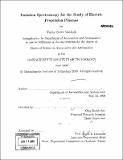Emission spectroscopy for the study of electric propulsion plasmas
Author(s)
Matlock, Taylor Scott
DownloadFull printable version (51.31Mb)
Other Contributors
Massachusetts Institute of Technology. Dept. of Aeronautics and Astronautics.
Advisor
Oleg Batishchev.
Terms of use
Metadata
Show full item recordAbstract
Typical electric propulsion devices rely on the acceleration of highly ionized plasmas to produce thrust at specific impulses unattainable with state-of-the-art chemical systems. This thesis examines the use of a miniaturized Helicon plasma source for an open-ended, electrode-less, cathode-less thruster through emission spectroscopy. The use of non-invasive diagnostics allows the measurement of important plasma parameters near the ionization region, where the plasma densities and temperatures are prohibitively high for typical electrostatic probes, while avoiding the inherent perturbations caused by invasive techniques. A spectral study of the Helicon antenna region, yielding axially resolved information on the electron temperature and degree of ionization, is discussed. A similar study in the near-field plume is presented, along with Doppler shift measurements, which clearly demonstrate continued acceleration upstream of the thruster exit. The Doppler shift measurements are validated by extending the study to a Hall effect thruster plasma, well characterized in the literature. Ion flux estimates from the downstream portion of the spectroscopic survey are compared with Faraday probe measurements. Possible mechanisms for thrust are presented along with their implications on Helicon thruster design.
Description
Thesis (S.M.)--Massachusetts Institute of Technology, Dept. of Aeronautics and Astronautics, 2009. Includes bibliographical references (leaves 121-124).
Date issued
2009Department
Massachusetts Institute of Technology. Department of Aeronautics and AstronauticsPublisher
Massachusetts Institute of Technology
Keywords
Aeronautics and Astronautics.